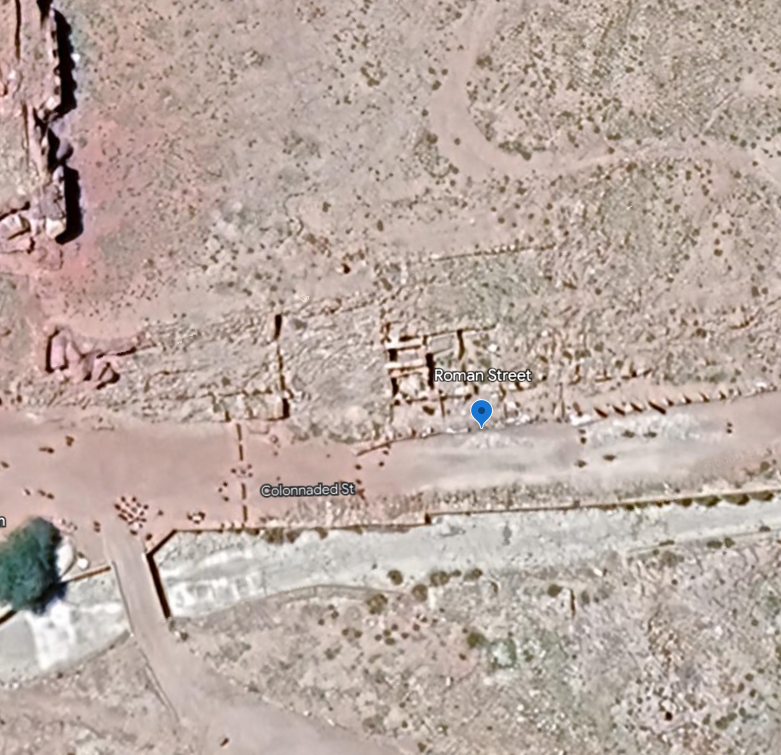Petra - Roman Street
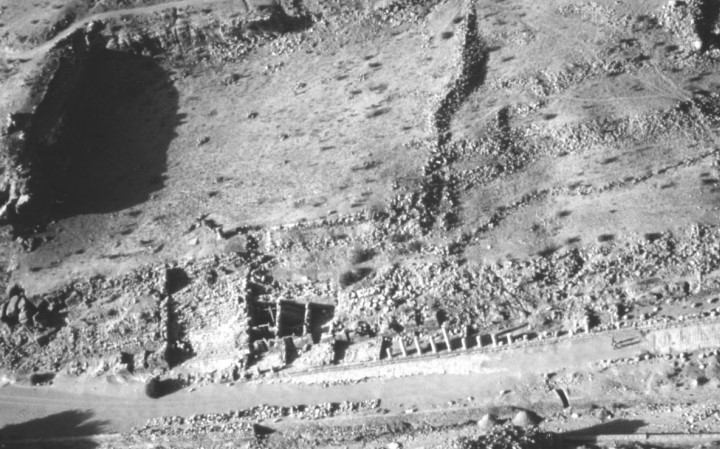 Fig. 5
Fig. 5The aerial view of the Roman Street Project excavations area (lower left)
Fiema (2008)
| Transliterated Name | Source | Name |
|---|---|---|
| The Roman Street |
In the Roman Street Project, excavations were performed on what appear to be shops or taverns located on the southern side of the eastern end of the colonnaded street directly west of the stairways that lead to the "Upper Market" ( Fiema, 2008).
- from Petra - Introduction - click link to open new tab
- Location Map from Jones (2021)
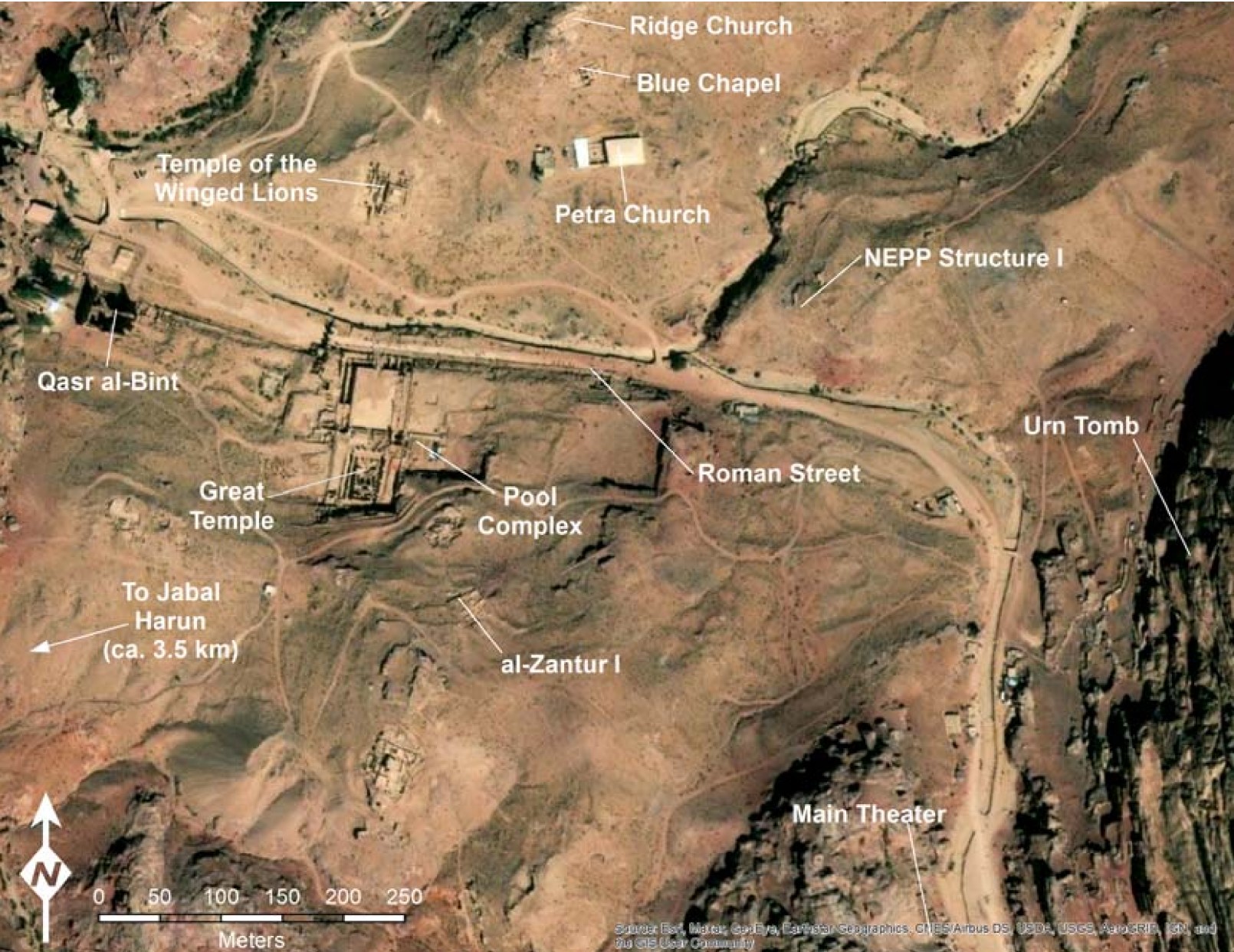
 Figure 2
Figure 2
Map of Petra with the locations of major excavations marked
Jones (2021)
Basemap: Esri, Maxar, Earthstar Geographics, USDA FSA, USGS, Aerogrid, IGN, IGP, and the GIS User Community - Roman Street in Google Earth
- Fig. 1 - Reconstructed plan
from Kanellopoulos (2001)

 Figure 1
Figure 1
Reconstructed ground plan of the street, Shops 23-32, the staircase and propylaea of the "Upper Market," and the pier(s) of the "Trajanic Arch." Hypothetical elements are rendered with hatched lines. Note the "ghost" of the Temenos Gate shifted 200 m east of the actual position of the monument.
Kanellopoulos (2001) - Fig. 1 - Plan of excavated
area of shops from Fiema (1998)

 Figure 1
Figure 1
Plan of excavated area of shops
(Drawing: Vesa Putkonen).
Fiema (1998)
- Fig. 1 - Reconstructed plan
from Kanellopoulos (2001)

 Figure 1
Figure 1
Reconstructed ground plan of the street, Shops 23-32, the staircase and propylaea of the "Upper Market," and the pier(s) of the "Trajanic Arch." Hypothetical elements are rendered with hatched lines. Note the "ghost" of the Temenos Gate shifted 200 m east of the actual position of the monument.
Kanellopoulos (2001) - Fig. 1 - Plan of excavated
area of shops from Fiema (1998)

 Figure 1
Figure 1
Plan of excavated area of shops
(Drawing: Vesa Putkonen).
Fiema (1998)
- Fig. 6 - Collapsed arches
in Room 28 from Fiema (1998)

 Figure 6
Figure 6
Room XXVIII. Collapsed arches
(Photo: Jan Vihonen).
Fiema (1998)
- Restoration drawing of
shops and steps from Kanellopoulos (1998)
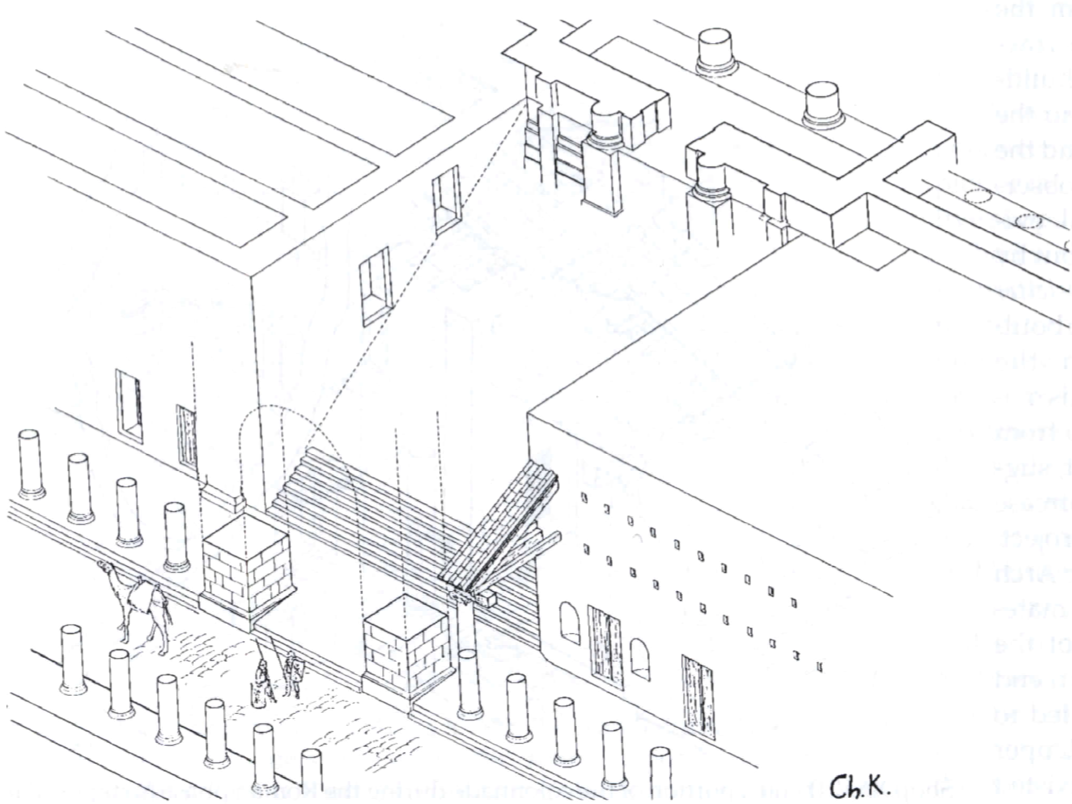
 Restoration drawing of the shops and steps
Restoration drawing of the shops and steps
Kanellopoulos (1998) - Shop 28 and a portion
of the colonnade during the Roman phase from Kanellopoulos (1998)

 Shop 28 and a portion of the colonnade during the Roman phase juxtaposed to adjacent Shop 27 as it could have looked during the early phase.
Shop 28 and a portion of the colonnade during the Roman phase juxtaposed to adjacent Shop 27 as it could have looked during the early phase.
Kanellopoulos (1998) - Axonometric reconstruction
of Shops 28 and 27 during the Byzantine phase from Kanellopoulos (1998)

 Axonometric reconstruction of Shops 28 and 27 during the
Byzantine phase with later structures built within the destroyed porch/sidewalk,
later round installation inside room 27, and hypothetical condition of ruined pier of the Trajanic Arch.
Axonometric reconstruction of Shops 28 and 27 during the
Byzantine phase with later structures built within the destroyed porch/sidewalk,
later round installation inside room 27, and hypothetical condition of ruined pier of the Trajanic Arch.
Kanellopoulos (1998)
Fiema (2008) reports three major phases for the Roman Street - Nabataean, Roman, and Byzantine.
- Axonometric reconstruction
of Shops 28 and 27 during the Byzantine phase from Kanellopoulos (1998)

 Axonometric reconstruction of Shops 28 and 27 during the
Byzantine phase with later structures built within the destroyed porch/sidewalk,
later round installation inside room 27, and hypothetical condition of ruined pier of the Trajanic Arch.
Axonometric reconstruction of Shops 28 and 27 during the
Byzantine phase with later structures built within the destroyed porch/sidewalk,
later round installation inside room 27, and hypothetical condition of ruined pier of the Trajanic Arch.
Kanellopoulos (1998) - Fig. 1 - Reconstructed plan
from Kanellopoulos (2001)

 Figure 1
Figure 1
Reconstructed ground plan of the street, Shops 23-32, the staircase and propylaea of the "Upper Market," and the pier(s) of the "Trajanic Arch." Hypothetical elements are rendered with hatched lines. Note the "ghost" of the Temenos Gate shifted 200 m east of the actual position of the monument.
Kanellopoulos (2001) - Fig. 1 - Plan of excavated
area of shops from Fiema (1998)

 Figure 1
Figure 1
Plan of excavated area of shops
(Drawing: Vesa Putkonen).
Fiema (1998)
Kanellopoulos (2001:16) speculated that a partial collapse of the upper story of Room 28 was caused by the southern Cyril Quake of 363 CE. Fiema (2008) further speculates that
in the area of the Colonnaded Street, damage must have included shifted walls, collapsed columns and arches, and a damaged pavement.Fiema (2008) added that
the [collonaded] street area appears to have been only partially rebuilt after the earthquakeand that subsequent constructions
were erected on the sidewalk with reused material, such as column drums, and even inscribed blocks.adding that
the drums used in the construction of these structures indicate that at least some parts of the colonnade had fallen down and were not restored.Fiema (1998:398) also discussed archaeoseismic evidence uncovered from previous excavations.
The disastrous earthquake which affected Petra on May 19, AD 363 (Russell 1980), would have spelled the end to some of the shops, or at least seriously limited their function. The shop excavated by Parr was definitely abandoned then, displaying a layer of destruction debris - Phase XV (Parr 1970: 366-368).
| Effect | Location | Image(s) | Description/Comments |
|---|---|---|---|
| Collapsed Walls - Partial Collapse of Upper Story | Room 28
 Axonometric reconstruction of Shops 28 and 27 during the
Byzantine phase with later structures built within the destroyed porch/sidewalk,
later round installation inside room 27, and hypothetical condition of ruined pier of the Trajanic Arch.
Axonometric reconstruction of Shops 28 and 27 during the
Byzantine phase with later structures built within the destroyed porch/sidewalk,
later round installation inside room 27, and hypothetical condition of ruined pier of the Trajanic Arch.Kanellopoulos (1998) 
 Figure 1
Figure 1Reconstructed ground plan of the street, Shops 23-32, the staircase and propylaea of the "Upper Market," and the pier(s) of the "Trajanic Arch." Hypothetical elements are rendered with hatched lines. Note the "ghost" of the Temenos Gate shifted 200 m east of the actual position of the monument. Kanellopoulos (2001) |
partial collapse of the upper story of Room 28 - Kanellopoulos, 2001:16 | |
| Displaced Masonry Blocks - Shifted Walls | in the area of the Colonnaded Street 
 Figure 1
Figure 1Reconstructed ground plan of the street, Shops 23-32, the staircase and propylaea of the "Upper Market," and the pier(s) of the "Trajanic Arch." Hypothetical elements are rendered with hatched lines. Note the "ghost" of the Temenos Gate shifted 200 m east of the actual position of the monument. Kanellopoulos (2001) |
in the area of the Colonnaded Street, damage must have included shifted walls, collapsed columns and arches, and a damaged pavement- Fiema (2008) |
|
| Fallen Columns | in the area of the Colonnaded Street 
 Figure 1
Figure 1Reconstructed ground plan of the street, Shops 23-32, the staircase and propylaea of the "Upper Market," and the pier(s) of the "Trajanic Arch." Hypothetical elements are rendered with hatched lines. Note the "ghost" of the Temenos Gate shifted 200 m east of the actual position of the monument. Kanellopoulos (2001) |
in the area of the Colonnaded Street, damage must have included shifted walls, collapsed columns and arches, and a damaged pavement- Fiema (2008) |
|
| Fallen Arches | in the area of the Colonnaded Street 
 Figure 1
Figure 1Reconstructed ground plan of the street, Shops 23-32, the staircase and propylaea of the "Upper Market," and the pier(s) of the "Trajanic Arch." Hypothetical elements are rendered with hatched lines. Note the "ghost" of the Temenos Gate shifted 200 m east of the actual position of the monument. Kanellopoulos (2001) |
in the area of the Colonnaded Street, damage must have included shifted walls, collapsed columns and arches, and a damaged pavement- Fiema (2008) |
|
| Damaged Pavement | in the area of the Colonnaded Street 
 Figure 1
Figure 1Reconstructed ground plan of the street, Shops 23-32, the staircase and propylaea of the "Upper Market," and the pier(s) of the "Trajanic Arch." Hypothetical elements are rendered with hatched lines. Note the "ghost" of the Temenos Gate shifted 200 m east of the actual position of the monument. Kanellopoulos (2001) |
in the area of the Colonnaded Street, damage must have included shifted walls, collapsed columns and arches, and a damaged pavement- Fiema (2008) |
|
| Rotated and displaced masonry blocks in walls and drums and columns surmised from re-used building elements | the Colonnaded Street 
 Figure 1
Figure 1Reconstructed ground plan of the street, Shops 23-32, the staircase and propylaea of the "Upper Market," and the pier(s) of the "Trajanic Arch." Hypothetical elements are rendered with hatched lines. Note the "ghost" of the Temenos Gate shifted 200 m east of the actual position of the monument. Kanellopoulos (2001) |
|
|
| Destruction Layer/Debris | The shop excavated by Parr 
 Figure 1
Figure 1Reconstructed ground plan of the street, Shops 23-32, the staircase and propylaea of the "Upper Market," and the pier(s) of the "Trajanic Arch." Hypothetical elements are rendered with hatched lines. Note the "ghost" of the Temenos Gate shifted 200 m east of the actual position of the monument. Kanellopoulos (2001) |
The shop excavated by Parr was definitely abandoned then, displaying a layer of destruction debris - Phase XV (Parr 1970: 366-368- Fiema (2008) |
- Earthquake Archeological Effects chart
of Rodríguez-Pascua et al (2013: 221-224)
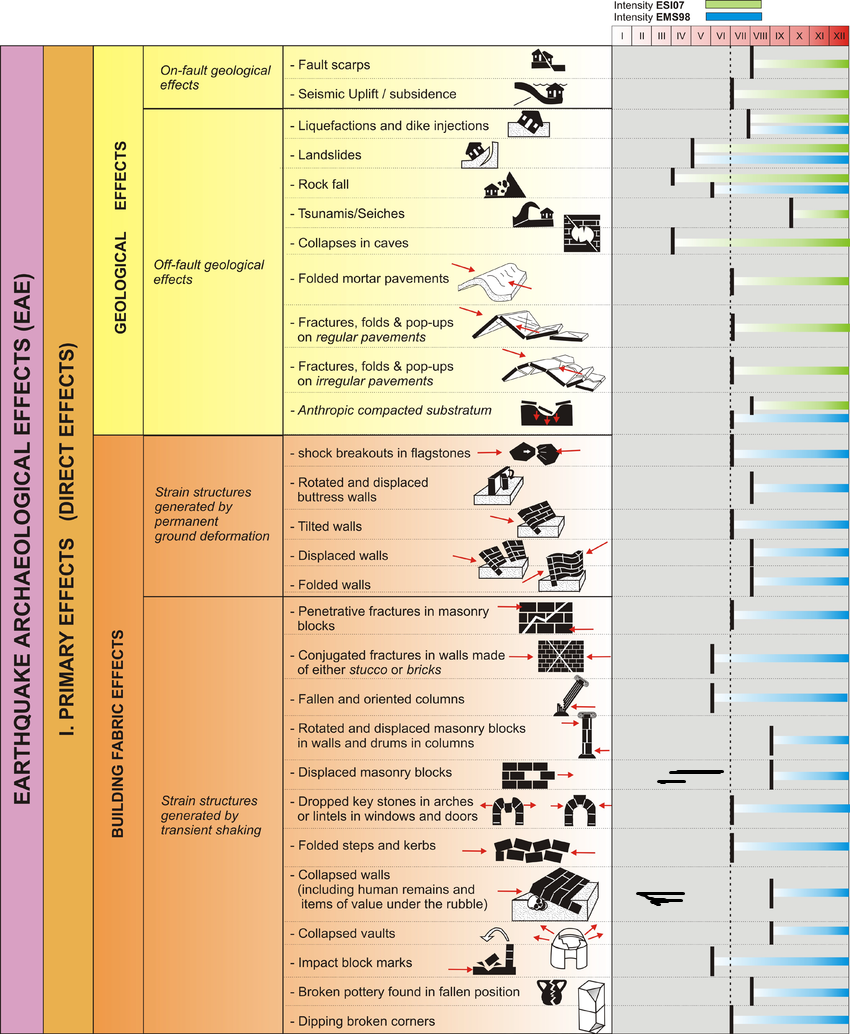
 Earthquake Archeological Effects (EAE)
Earthquake Archeological Effects (EAE)
Rodríguez-Pascua et al (2013: 221-224)
| Effect | Location | Image(s) | Description/Comments | Intensity |
|---|---|---|---|---|
| Collapsed Walls - Partial Collapse of Upper Story | Room 28
 Axonometric reconstruction of Shops 28 and 27 during the
Byzantine phase with later structures built within the destroyed porch/sidewalk,
later round installation inside room 27, and hypothetical condition of ruined pier of the Trajanic Arch.
Axonometric reconstruction of Shops 28 and 27 during the
Byzantine phase with later structures built within the destroyed porch/sidewalk,
later round installation inside room 27, and hypothetical condition of ruined pier of the Trajanic Arch.Kanellopoulos (1998) 
 Figure 1
Figure 1Reconstructed ground plan of the street, Shops 23-32, the staircase and propylaea of the "Upper Market," and the pier(s) of the "Trajanic Arch." Hypothetical elements are rendered with hatched lines. Note the "ghost" of the Temenos Gate shifted 200 m east of the actual position of the monument. Kanellopoulos (2001) |
partial collapse of the upper story of Room 28 - Kanellopoulos, 2001:16 | VIII+ | |
| Displaced Masonry Blocks - Shifted Walls | in the area of the Colonnaded Street 
 Figure 1
Figure 1Reconstructed ground plan of the street, Shops 23-32, the staircase and propylaea of the "Upper Market," and the pier(s) of the "Trajanic Arch." Hypothetical elements are rendered with hatched lines. Note the "ghost" of the Temenos Gate shifted 200 m east of the actual position of the monument. Kanellopoulos (2001) |
in the area of the Colonnaded Street, damage must have included shifted walls, collapsed columns and arches, and a damaged pavement- Fiema (2008) |
VIII+ | |
| Fallen Columns | in the area of the Colonnaded Street 
 Figure 1
Figure 1Reconstructed ground plan of the street, Shops 23-32, the staircase and propylaea of the "Upper Market," and the pier(s) of the "Trajanic Arch." Hypothetical elements are rendered with hatched lines. Note the "ghost" of the Temenos Gate shifted 200 m east of the actual position of the monument. Kanellopoulos (2001) |
in the area of the Colonnaded Street, damage must have included shifted walls, collapsed columns and arches, and a damaged pavement- Fiema (2008) |
V+ | |
| Fallen Arches | in the area of the Colonnaded Street 
 Figure 1
Figure 1Reconstructed ground plan of the street, Shops 23-32, the staircase and propylaea of the "Upper Market," and the pier(s) of the "Trajanic Arch." Hypothetical elements are rendered with hatched lines. Note the "ghost" of the Temenos Gate shifted 200 m east of the actual position of the monument. Kanellopoulos (2001) |
in the area of the Colonnaded Street, damage must have included shifted walls, collapsed columns and arches, and a damaged pavement- Fiema (2008) |
VI+ | |
| Rotated and displaced masonry blocks in walls and drums and columns surmised from re-used building elements | the Colonnaded Street 
 Figure 1
Figure 1Reconstructed ground plan of the street, Shops 23-32, the staircase and propylaea of the "Upper Market," and the pier(s) of the "Trajanic Arch." Hypothetical elements are rendered with hatched lines. Note the "ghost" of the Temenos Gate shifted 200 m east of the actual position of the monument. Kanellopoulos (2001) |
|
VIII+ |
Fiema, Z. T. 1998, The Roman Street of the Petra Project, 1997. A Preliminary Report. Annual of the Department of Antiquities of Jordan 42, 1998, 395–424.
Fiema, Z. T. 1997. “Petra: Roman Street Project,” ACOR Newsletter 9 (1): 8–9.
Fiema, Z.T. 2001. “Die Entdeckung der Antiken Innenstadt. Neue Forschungen im
Bereich der Säulenstrasse in Petra/Jordanien.” Antike Welt. Zeitschrift für Archäologie und Kulturgeschichte 32 (1): 47–52.
Fiema, Z. T. 2008. “Remarks on the Development and Significance of the Colonnaded Street in Petra, Jordan.”
In La rue dans l’antiquité: définition,aménagement, devenir. Actes du colloque de Poitiers, 7–9 Septembre 2006, edited by P.
Ballet, N. Dieudonné-Glad, and C. Saliou, 161–168. Rennes: Presses universitaires.
Kanellopoulos, C. 1998. “Petra: Colonnaded Street and Shops” ACOR Newsletter 10 (1): 1–3.
Kanellopoulos, C. 2001. “The Architecture of the Shops and Colonnaded Street in Petra.”
Bulletin of the American Schools of Oriental Research 324: 9–22. DOI: 10.2307/1357629.
Kanellopoulos, C. 2002. “A New Plan of Petra’s City Center.” Near Eastern Archaeology 65 (4): 251–254.
Hammond, P. C. (1960). "Excavations at Petra in 1959." Bulletin of the American Schools of Oriental Research(159): 26-31.
Paradise, T. 2011. The Great Flood of Petra: evidence for a 4th-5th AD century catastrophic flood. Annual of the Department of Antiquities of Jordan 55: 43-56.
Parr, P. 1960 Excavations at Petra, 1958-59. PEQ 92: 124-136.
Parr, P. 1970 A Sequence of Pottery from Petra. Pp. 348-381 in J. A. Sanders (ed.), Near Eastern Archaeology in the Twentieth Century.Garden City. - can be borrowed with a free account from archive.org
Parr, P. 1986 The Last Days of Petra. Pp. 192-205 in M.A. Bakhit and M. Asfour (eds), Proceedings of the Symposium on Bilad al-Sham during the Byzantine Period (November 1983) II. Amman.
Parr, P. 1996 The Architecture of Petra: Review Article. PEQ 128: 64-70.
